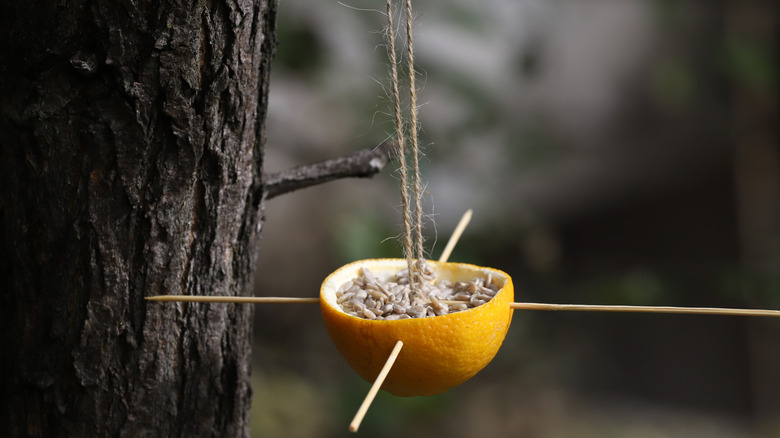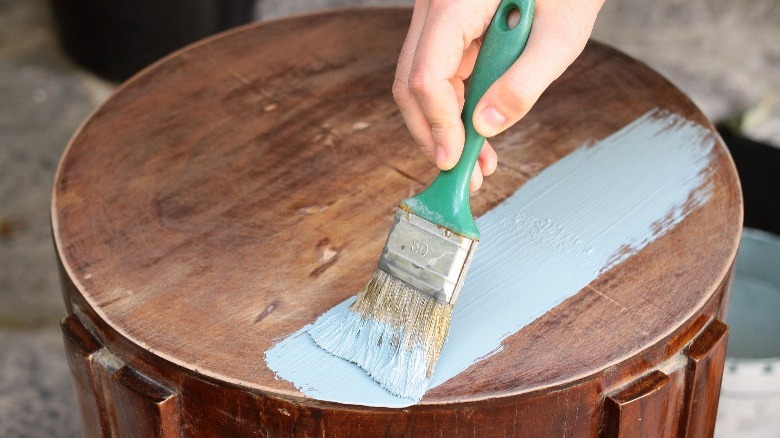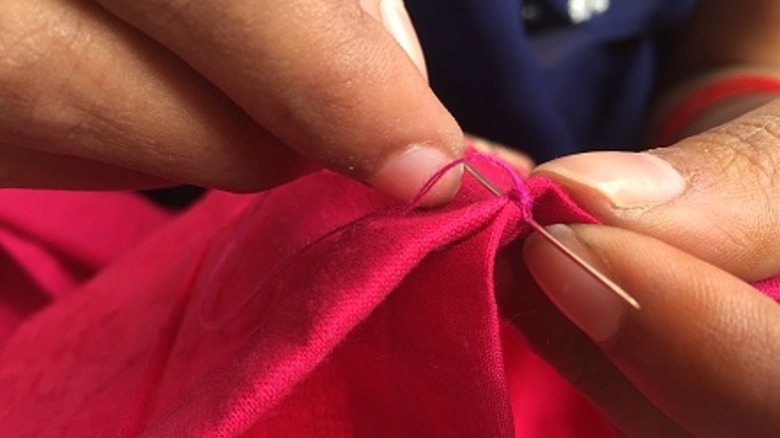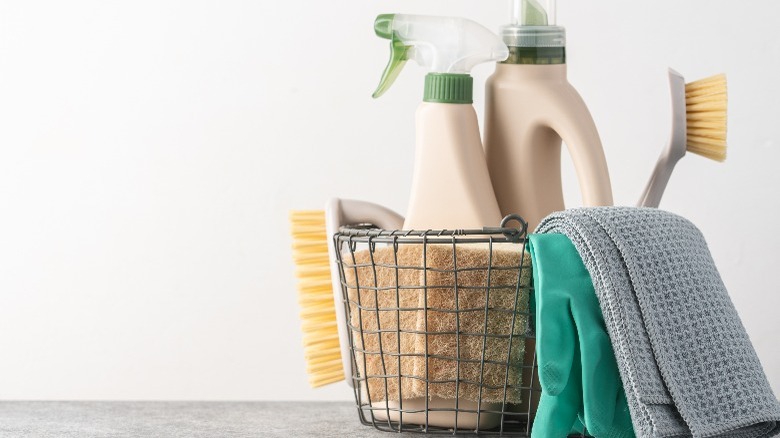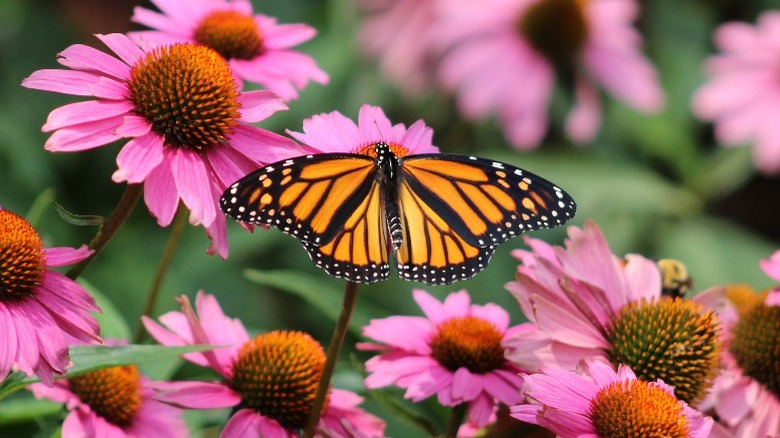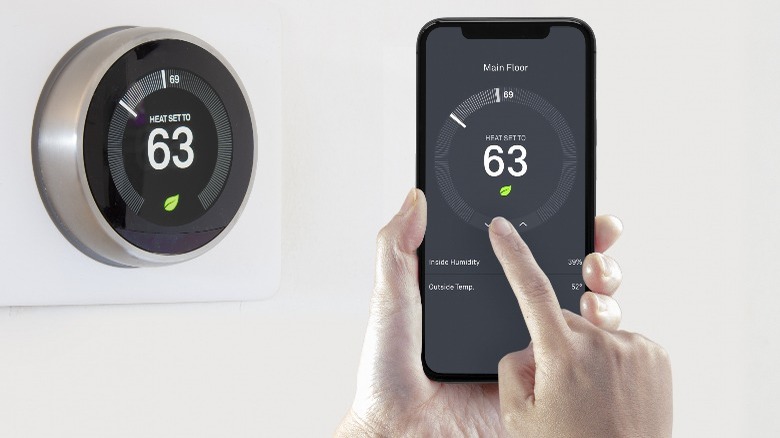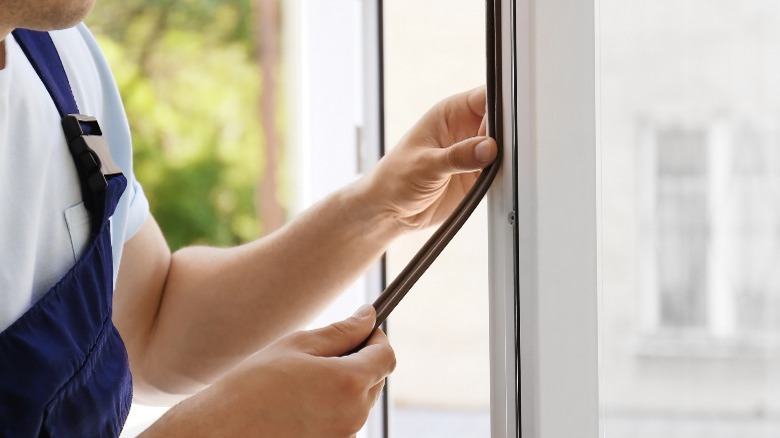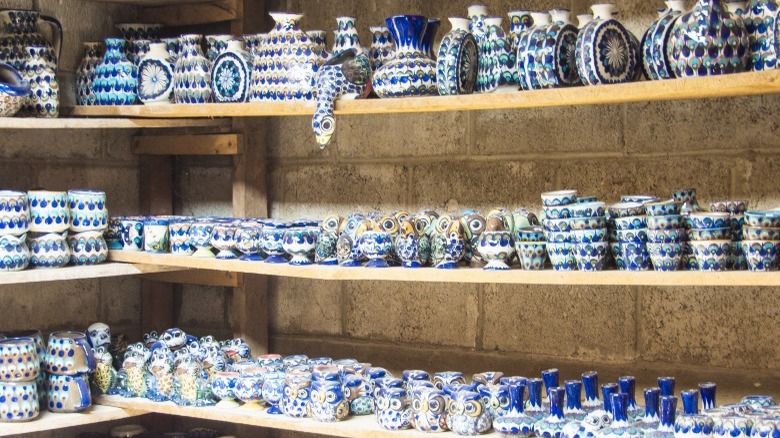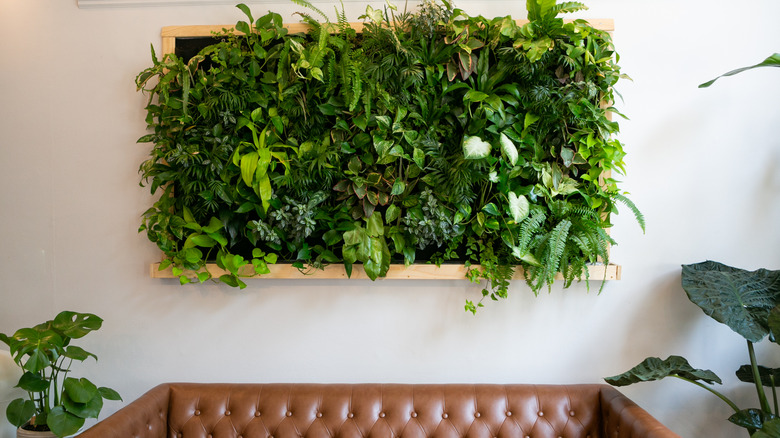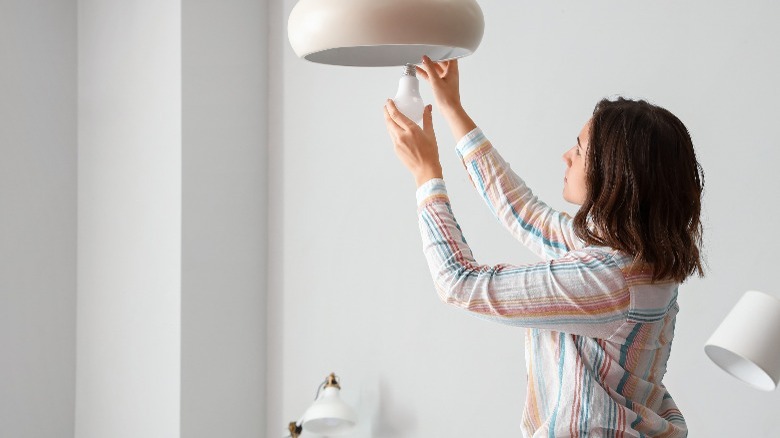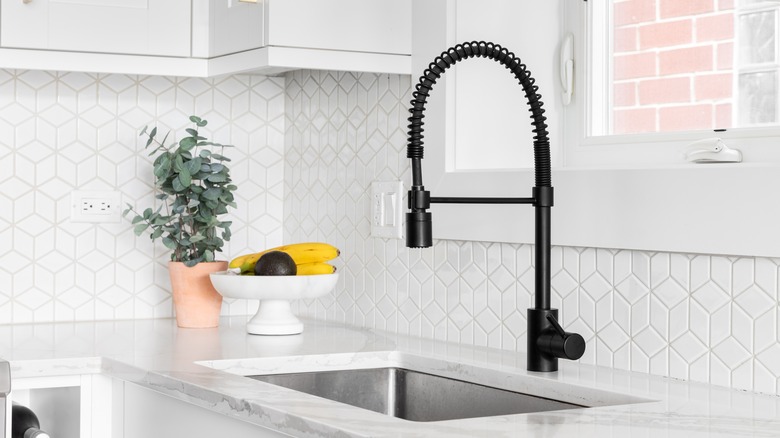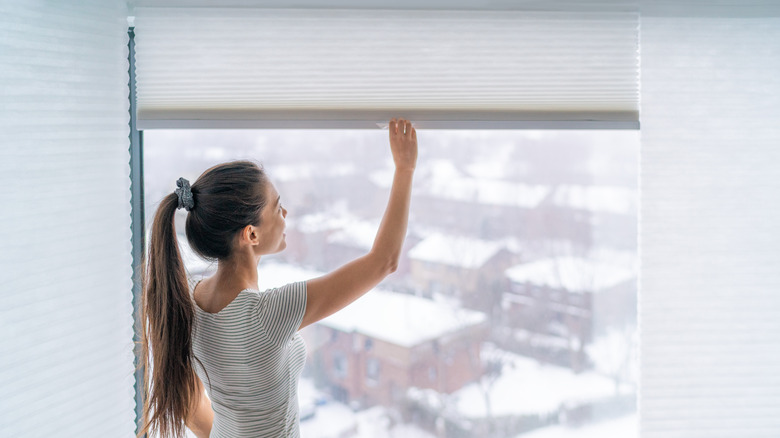12 Sustainable Home Hacks To Celebrate Earth Day
Earth Day is April 22, 2023, and even though it isn't a federally-recognized holiday, this is the perfect opportunity to dig into projects that improve your home and outdoor space in sustainable ways. This special day is all about spotlighting the importance of environmental awareness and the most effective, actionable steps. While attending Earth Day events like cleaning up parks can be rewarding and good for the environment, there are plenty of hacks that can be done right in your own backyard — and inside your house, too.
Sustainable home hacks are designed to use low-impact, materials and effective methods that conserve natural resources. These are different from major renovations like installing solar panels or high-performance windows and require significantly less time and effort. They are smaller projects that offer easy ways to celebrate this important day. Some are very family-friendly while others are more geared toward do-it-yourselfers. And while these hacks might require an initial monetary investment, most can save homeowners money in the long run.
1. Make a bird feeder
This project is rewarding in so many ways. It requires minimal time and effort, costs next to nothing, and can provide hours of entertainment. A homemade bird feeder is also an excellent opportunity for nature photographers who want to practice their craft. The most eco-friendly birdfeeders are made by hand with sustainable parts. And next to pouring birdseed into a bowl, the easiest one to make is from half an orange.
Find a large, fresh orange, slice it in half, and carefully remove the flesh and pith, creating a makeshift bowl. Push two wooden skewers close to the top edges, forming a cross shape. Then, slice the sharp ends off with a knife. Cut out a length of twine or string and loop it around the point where the skewers cross. Tie the ends together to create a loop for hanging. This cool, sustainable bird feeder can be suspended from a tree branch or a shepherd's hook. Fill the hollowed-out orange with birdseed, back away, and get ready for the show.
2. Refinish old furniture
Old wood furniture doesn't always have to be donated or thrown out when it still has life left in it. If any is just sitting around the house, Earth Day is a great time to tackle a furniture refinishing project. Look for pieces with solid construction and check for loose parts and damage. Some older furniture might need regluing and re-tightening so have some tools and materials handy.
The chosen piece needs to be thoroughly cleaned before it can be refinished. This is best done with gentle dish soap, water, a clean sponge, and a toothbrush to get into any nooks and crannies. Once it's dried, the finish can be removed with sandpaper or a power sander. Chemical strippers can be used but aren't as eco-friendly. Once that step is completed the furniture can be wiped down and a primer can be applied. Then, it can be painted a new fun shade and sealed. The most eco-friendly paint products contain fewer gases or airborne chemicals known as Volatile Organic Compounds (VOCs). Some of the best manufacturers of these products include ECOS Paint and The Real Milk Paint Co.
3. Make homemade cleaning cloths
It's amazing how quickly families go through rolls of paper towels. Not only is this bad for the environment but using so many of them is also like throwing money away. But, some homes don't even use them at all while others use a combination of paper towels and cleaning cloths. These cloths can be used countless times as long as they're washed thoroughly when dirty. Microfiber towels serve this purpose, but homemade versions can be even better. Plus, you might get a better sense of satisfaction when using cleaning cloths that are made by hand.
To make homemade cleaning cloths, start with a yard of absorbent fabric like terry cloth. Cut out two pieces and lay one on top of the other, with the wrong sides facing out. Sew around the borders, leaving half-inch seam and a small opening. Trim the edges, turn the piece inside out, and stitch up the opening. The edges can be top-stitched for a more finished look, but that isn't necessary for functionality.
4. Mix up DIY green cleaning products
Earth Day is a perfect chance to switch to DIY green cleaning products. These can be mixed up with household ingredients and poured into recycled cleaning product spray bottles or other containers. It's best to have clean ones ready before the ingredients are combined, plus a funnel to pour the DIY cleaners into bottles with narrow openings.
A basic all-purpose cleaner can be made from ½ cup of vinegar and ¼ cup of baking soda. Add those to the bottle and fill it with hot water. You can also a drop or two of essential oil to help offset the vinegar smell. To make an effective eco-friendly kitchen spray that kills germs like salmonella and E. coli, heat up 5% vinegar or 3% hydrogen peroxide, pour it into a spray bottle, and spritz away. That should sit for one minute before being wiped away. For mirrors and glass, add ½ cup vinegar to one gallon of water and clean the surfaces with that and a microfiber cloth.
Those three DIY cleaners are just the beginning. Toilets can be cleaned with vinegar and baking soda and moldy showers can be cleaned with borax and vinegar or a bit of rubbing alcohol mixed into water. These ingredients can be combined in other ways, but never mix vinegar and hydrogen peroxide. Combining ammonia and bleach is another no-no because both of these combinations produce toxic fumes.
5. Plant a pollinator garden
Much of the food crops in the world rely on pollinator animals and insects for survival. Welcoming these visitors with pollen ensures ongoing plant, fruit, and vegetable production. Pollinator gardens are an excellent way to support the food ecosystem and serve as educational tools for those who observe them. These gardens can be planted in the spring, perfect timing for Earth Day when the weather permits. Pollinators like bees, butterflies, and birds are attracted to certain greenery and once it is planted, they will be thrilled to visit your yard.
Pollinators are drawn to sunny locations, so the garden should be in an area that gets a lot of light. The choice of plants is wide and varied, but certain pollinators are more attracted to specific plants. For example, birds and swallowtail butterflies like milkweed and bees are into lavender. Other good choices include zinnias, goldenrod, coneflower, and aster. Feel free to mix up several species and experiment with bold, bright blooms for an attractive pop of color in your yard.
6. Install a smart thermostat
Anyone who has ever forgotten to turn off the heat or AC and was dismayed to see a sky-high utility bill can benefit from installing a smart thermostat. These units use phone apps and Wifi to manage a home's climate. So instead of constantly adjusting old-fashioned settings, users can change the temp and fan with a few quick taps. These easy-to-use systems conserve energy, and that saves homeowners money.
Before buying a smart thermostat, do the research to ensure that the system is compatible with the existing wiring. The new unit will have the manufacturer's installation instructions, but there are some basic guidelines. Turn off the HVAC system and remove the thermostat's faceplate. Snap a photo of the wiring to use as a reference of how the lines are connected. Then, unscrew the backplate and add a C-wire if needed.
Mark a spot for the new template on the wall, screw it in, and connect the smart thermostat's wires, using the photo as a reference. Next, the new faceplate can be attached and the HVAC system turned back on. Now comes the fun part – connecting the cool new smart thermostat to the Wifi and getting the app on your phone.
7. Seal up leaks
That costly utility bill can also be reduced when homeowners seal up air leaks around the house. Cold and hot air can travel in and out, causing the HVAC to turn on and keep running for hours on end. The most common spots for leaks include fireplace walls, switchplates, windows, doors, and attics. This Earth Day, set up an energy use assessment through your provider or get the right supplies and tools to seal up those leaks.
Caulk and weatherstripping can be used to seal the sides and corners around windows and doors. It also works well where wiring and ducts come through walls, ceilings, and floors. For larger gaps, use foam sealant. Unscrew switch plates and install foam gaskets inside, and keep the fireplace flue closed unless it's being used. To seal air leaks around fireplaces and furnaces, install barriers made from fire-safe materials like sheet metal and cement caulk made for furnaces.
8. Purchase a home decor item from a green company
What better way to celebrate Earth Day than with a thoughtfully-chosen, sustainable home decor item? There's no need to worry about finding one because there are more green companies in this niche than ever before, with products at different price points. One green home decor company is Armadillo, which features high-end natural rugs and holds a B Corp certification. Likhâ is another great resource. Here you can find sustainably produced, appealing home decor items like planters, coasters, and ornaments. These pieces are made by Filipino artists who use native, natural materials like hemp and coconut coir. Other green home decor retailers to browse include The Citizenry, Ten Thousand Villages, and Parachute.
When shopping for sustainable home decor goods, look for companies that only use natural materials and employ Fair Trade practices. Many reinvest money and other resources into their companies, helping the people who make their products. The websites usually provide extensive information about all of this — after all, it's a major selling point for environmentally-conscious consumers.
9. Create an indoor plant wall
Carefully chosen shelving and artwork inject personality into wall space. But creating an indoor plant wall makes a more unique statement and establishes a positive connection between plants and people. This was trending on social media a few years back and the idea stuck, and making one is a great project for Earth Day. To get started, pick a wall that gets a lot of light and remove everything on it. Low-maintenance houseplants like philodendron and anthurium are best for newbies but other ones can be experimented with once the wall is established.
Plant wall systems can be purchased online or can be built with materials like pieces of wood for the frame and chicken wire to hold the plants. Landscaping fabric can also be used but all the materials should be durable and water-resistant. A frame has to be built and supported on the wall and once that's mounted, angled plant trays can be installed. Premade plant wall systems often have built-in watering capabilities, but homemade plant walls need to be watered just like houseplants.
10. Change incandescent lights to LED
LED lights are not a new technology, but many people still have incandescent bulbs throughout their homes. The LED acronym stands for light-emitting diode and. these energy-efficient lights use at least 75 percent less power than incandescent ones. They are much cooler to the touch and last a lot longer. They're also manufactured with epoxy lenses instead of glass, so they don't break as easily. Throughout the next decade, more and more of them will likely be used in the U.S. and there's no better place to start than at home. And when shopping for them, look for ones that are ENERGY STAR rated. That way, you'll know that you're getting the most energy-efficient ones available.
Besides LED replacement bulbs for lamps, there are recessed LED downlights for ceilings, under-cabinet LED lights, and LED holiday lights. The replacement bulbs are affordable and made to fill in for 40, 60, 75, and 100-watt incandescent bulbs. This Earth Day, buy all of your new bulbs and replace the old ones room by room. Since LED lights use less energy, homeowners often see their energy bills go down. And just as importantly, these last up to 30 times longer than incandescent lights so they don't need to be replaced as often.
11. Change up faucets and shower heads
Bathroom and kitchen faucets typically run at four gallons a minute and that can lead to a lot of waste. Replacing a faucet with a low-flow model takes time, but the flow can be reduced to 2.5 gallons per minute with an inexpensive faucet aerator. These small attachments get screwed onto the ends of faucets and can decrease the flow as much as a water-saving faucet. This a simple way to conserve water and are super easy to install.
A shower water flow restrictor can serve the same purpose as an aerator and these can be built into low-flow shower heads. They aren't hard to install and can decrease excess water usage by up to 60 percent. Homeowners hesitate to switch over because they worry about a lack of water pressure, but this isn't necessarily an issue. Aerating showerheads force water through small screens so the spray is fine but still strong. Laminar showerheads are a second option that creates larger, singular water streams that can be adjusted.
To replace a showerhead, unscrew the old one with an adjustable wrench, working carefully not to damage the pipe threading. Remove any debris on the end of the pipe with a wire brush, wipe it clean, and cover it with plumber's tape for a watertight seal. The new showerhead can be screwed onto the end by hand and tightened up with the wrench. Avoid attaching it too tightly to prevent cracking. Turn on the water and check for leaks and remove and reinstall if needed.
12. Put up energy-conserving window treatments
Installing new energy-efficient windows can run into tens of thousands of dollars and this certainly isn't a one-day project. A more reasonable Earth Day upgrade is to install energy-conserving window treatments that will look beautiful and save money. The best choices are blinds or curtains that effectively keep out the light when needed and prevent heat from escaping in the wintertime. Cellular (honeycomb) shades are a good energy-efficient option and are often more durable than traditional horizontal blinds. They are usually manufactured from spun lace and polyester and come in a range of colors and sizes, and darker ones provide the most light filtering. Honeycomb shades are made with layers of cells that insulate windows, and can be dusted clean.
Shutters are thicker and made from wood, wood composite, or vinyl. Made with horizontal slats, they act as barriers over windows and can be installed around windows or inside the frames. Curtains are another option, and lined ones look nicer and offer more energy savings. For the most efficiency, mount them on the outsides of the windows to get better coverage.

